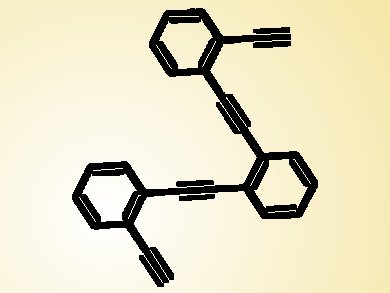Graphene nanostructures are becoming increasingly important for electronic devices. However, to mass produce them engineering of graphene nanostructures has to be possible with atomic precision.
Michael F. Crommie and Felix R. Fischer, Lawrence Berkeley National Laboratory, Berkeley, CA, USA, and colleagues created a 2D system containing of an oligo-enediyne (pictured) on a silver surface. They then induced reactions by heating it. To see what was happening at the single-atom level, the team used noncontact atomic force microscopy (nc-AFM). To the teams surprize the nc-AFM microscopy provided single-bond-resolved images of individual molecules, making it possible to observe the chemical transformation of an individual molecule as it undergoes a complex organic reaction.
The results made clear that the reaction produced two different molecules via a complex surface reaction mechanisms underlying thermally induced cyclization cascades and, more important, gave promise that this new method may be used for building advanced nanoscale electronic devices from the bottom up.
However, the team says large discoveries lie ahead before much more complex graphene nanostructures can result from this unique approach.
- Direct Imaging of Covalent Bond Structure in Single-Molecule Chemical Reactions,
Dimas G. de Oteyza, Patrick Gorman, Yen-Chia Chen, Sebastian Wickenburg, Alexander Riss, Duncan J. Mowbray, Grisha Etkin, Zahra Pedramrazi, Hsin-Zon Tsai, Angel Rubio, Michael F. Crommie, Felix R. Fischer,
Science 2013.
DOI: 10.1126/science.1238187



